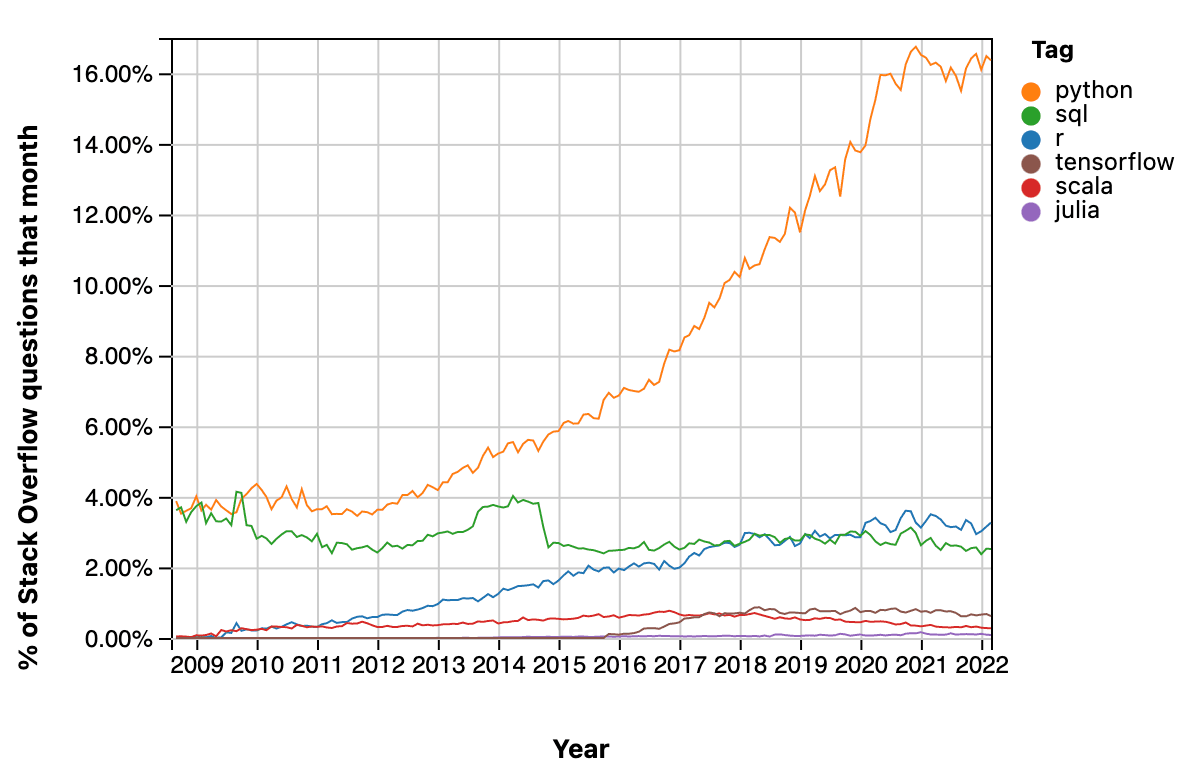The world of data science, machine learning, and artificial intelligence keeps growing fast. They can be applied in almost any industry to create massive improvements in efficiency. Data science can be used to gain insights, predict the future and allow computers to make decisions. In this article, we will explore 5 important trends in data science for 2022. Let’s begin!
1. Python Growing In Popularity
A trend that’s been happening for the past few years (and has only accelerated) is the popularity of Python as a coding language for data science and machine learning projects. This is largely because of the user-friendly syntax and extensive, open-source libraries available. According to Bharath K: “Python is the best way for anyone to get started with machine learning, even people with no prior experience with programming”. From the graph below, we can also see how the popularity has grown compared to other data science languages since 2009.

2. Edge Computing + 5G
Commercial access to the internet combined with an explosion of mobile devices gave rise to modern data centers. One big constraint is that mobile devices are always some distance from the data center, which causes latency between a request and the delivery of data. This can become a matter of life and death, for example with autonomous vehicles or fail-safe mechanisms that need to have answers faster than the latency gap.
Edge computing aims to solve this problem by increasing the amount of local computing power. What this means is that mobile devices can process more data locally, thus reducing the need for data to travel between data centers.
5G drastically reduces latency between a data center and edge devices. Oscar GR notes that “5G will cause a proliferation of sensors around us, and each of those sensors opens up new opportunities for analyzing data and creating machine learning models”. So the combination of stronger mobile devices along with lower latency will allow data science to flourish.
3. Low-Code/No-Code AI
Another major innovation is the rise of Low-code and No-code development platforms. To cite Isaac Sacolick: “Low-code platforms provide drag-and-drop interfaces to design screens, workflows, and data visualizations used in web and mobile applications”. What this means is that people can now start leveraging A.I. tools without having a software developer background.
Low-code platforms enable the democratization of A.I. These platforms enable anyone with basic computer knowledge to apply ML models. This is comparable to the transition from command-line interfaces in the 1970s to GUIs in the 1980s. This allowed anyone to instruct a computer, leading to an enormous explosion in productivity and wealth creation. Similarly, allowing more creative people to leverage the power of ML tools can also lead to a revolution.
4. Feature Stores for ML
Feature Stores are a popular new trend with large organizations because they streamline one crucial part of machine learning: feature engineering. This is the process of extracting features from raw data to improve predictive models. Rather than identifying features for common item classes every time, the Feature Store serves as a database for recurring features, thus making it faster to process the data and train the model.
Since feature engineering is time-consuming, building a feature store can save heaps of time.
Adi Hirschtein elaborates in his blog post: “Every data science project starts with searching for the right features. When a data scientist starts a new project, he or she can go to this catalog and easily find the features they are looking for.” This is particularly valuable for large companies that are often dealing with the same features in their machine learning models.
5. Algorithmic Bias Safeguards for the Workforce
One final initiative we want to mention is the Algorithmic Bias Safeguards For the Workforce. This initiative is part of a larger trend in data science: creating an ethical and unbiased A.I.
The Data & Trust Alliance is a not-for-profit consortium that brings together leading businesses and institutions to learn, develop and adopt responsible data and AI practices. According to their paper, alliance member organizations identified unfair bias as one of the highest risks in the workforce. This prompted the Alliance to develop the Algorithmic Bias Safeguards for Workforce—criteria and education for HR teams to evaluate vendors on their ability to detect, mitigate and monitor algorithmic bias in workforce decisions. You can find the entire paper here.
We added this as an important trend because A.I. is becoming a powerful tool that’s invading almost every sector of the economy. While it’s generally thought to improve our quality of life, we still need to be careful that it benefits everyone equally. With great power comes great responsibility, and we are excited to see organizations stepping up to create a fair A.I. that benefits everyone.
To stay updated on current trends and news in data science, visit our Vectice blog!



























